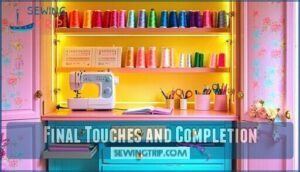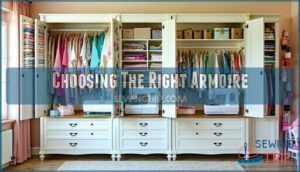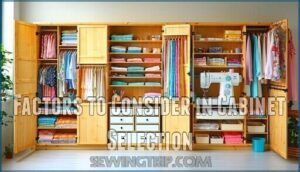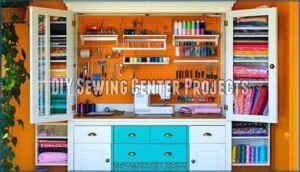This site is supported by our readers. We may earn a commission, at no cost to you, if you purchase through links.
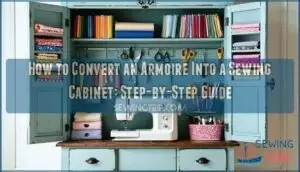
Install adjustable shelving using sturdy plywood that’ll handle your heaviest sewing machine without breaking a sweat. Add LED strip lights for proper visibility and heavy-duty drawer slides that won’t wobble under pressure.
Mount pegboards inside doors for scissors and tools, then create custom drawer dividers for bobbins and notions. Apply chalk paint and distressing techniques for that vintage charm that makes store-bought cabinets jealous.
The secret lies in maximizing every inch while keeping frequently-used items within arm’s reach.
Table Of Contents
- Key Takeaways
- Materials for Armoire Conversion
- Preparation and Cleaning
- Shelving Installation
- Antiquing and Reassembly
- Organization Accessories
- Final Touches and Completion
- Choosing The Right Armoire
- Factors to Consider in Cabinet Selection
- Creative Storage Ideas
- DIY Sewing Center Projects
- Frequently Asked Questions (FAQs)
- Conclusion
Key Takeaways
- Start with proper prep work – You’ll need to remove all hardware, clean thoroughly, and sand surfaces before making any modifications to ensure your conversion succeeds.
- Install heavy-duty components – You’ll want quality drawer slides, adjustable shelving, and LED lighting that can handle your sewing machine’s weight and provide proper workspace visibility.
- Maximize storage with smart organization – You can add pegboards inside doors, create custom drawer dividers for notions, and use vertical space efficiently to keep supplies accessible.
- Focus on ergonomic design – You’ll get the best results by positioning your sewing machine at elbow height and keeping frequently-used items within arm’s reach for comfortable, long crafting sessions.
Materials for Armoire Conversion
Before diving into your armoire conversion, you’ll need specific materials to transform this furniture piece into a functional sewing station. Start with quality paint options for both interior and exterior surfaces—chalk paint works beautifully for that vintage craftsman look.
Select heavy-duty drawer slides that’ll handle your sewing supplies without wobbling. Install LED lights inside for proper visibility during detailed work.
Add a bulletin board for patterns and a pegboard for organizing tools. Don’t forget file organizers for keeping fabric swatches sorted and accessible throughout your shelving installation process.
Preparation and Cleaning
Before tackling your armoire conversion, you’ll need to strip everything down to the bare bones. This vital step sets the foundation for a professional-looking cabinet conversion that’ll make your sewing space shine.
Essential preparation steps:
- Remove all hardware, doors, hinges, and drawer slides for a complete surface assessment.
- Perform a thorough interior scrub with a mild wood cleaner to eliminate years of accumulated grime.
- Complete dust removal from every corner and crevice using a vacuum and microfiber cloths.
- Apply mold prevention treatment to guarantee your armoire makeover stays fresh and clean.
Label each component during hardware removal—you’ll thank yourself later during reassembly. Light sanding smooths rough spots and prepares surfaces for antiquing techniques that’ll transform your piece into a stunning sewing cabinet.
Shelving Installation
Before you start your shelving installation process, measure twice and cut once—this old carpenter’s wisdom will save you headaches later. The right shelf materials and mounting techniques make all the difference in your armoire conversion success. For those seeking supplies, consider armoire shelving options.
Measure twice, cut once—this carpenter’s wisdom prevents costly conversion mistakes and ensures perfect shelving fits
Here’s what you’ll need for proper shelving installation:
- Shelf Materials: Choose sturdy plywood or solid wood that matches your cabinet conversion aesthetic
- Adjustable Shelves: Install bracket systems that let you customize shelf spacing as your sewing needs change
- Weight Capacity: Calculate the load your shelves will carry—sewing machines and fabric bolts aren’t lightweight
- Mounting Techniques: Use proper wall anchors and brackets to secure your armoire sewing cabinet shelving safely
Antiquing and Reassembly
With your shelving securely in place, you’re ready to give your armoire conversion that coveted vintage character. Apply aging techniques like distressing or antiquing gel to create authentic wear patterns on the exterior surfaces.
During reassembly, focus on hardware restoration by upgrading hinges and pulls with quality black metal pieces. Joint reinforcement becomes critical now—check all connections and tighten loose screws before proceeding.
To maximize comfort, consider ergonomic furniture benefits for long sewing sessions. Maintain reassembly alignment by dry-fitting components first, ensuring doors swing smoothly and drawers slide effortlessly.
Your antique armoire transformation depends on these careful finish preservation steps.
Organization Accessories
Organization accessories transform your converted armoire into an efficient sewing cabinet. Smart storage solutions prevent the chaos that often plagues crafters’ workspaces. Here’s how to maximize your storage space:
Transform chaos into craft-room bliss with smart storage that makes every supply accessible
- Pegboard Systems – Mount panels inside doors for hanging scissors, rulers, and frequently-used tools
- Drawer Dividers – Create custom compartments for bobbins, pins, and small notions using adjustable organizers
- Lighting Solutions – Install LED strips under shelves to illuminate your workspace and thread colors
- Hardware Choices – Select knobs and pulls that match your aesthetic while providing easy access
- Compact Workstations – Add fold-down tables or pull-out surfaces for cutting and pressing tasks
To make the most of vertical space, consider implementing a pegboard wall system. These sewing supplies organizers keep everything visible and within reach.
Final Touches and Completion
Your beautifully organized sewing cabinet deserves the perfect finishing touches. Apply decorative hardware like vintage knobs to enhance your armoire conversion’s charm. Install workspace lighting with LED strips for clear visibility during detailed projects. Choose paint colors that reflect your creative spirit—soft pastels or bold jewel tones work wonderfully. A well-organized armoire can substantially boost project completion rates.
Complete your ergonomic setup by adjusting shelf heights for comfortable reach. During reassembly, perform alignment checks to guarantee smooth drawer operation.
Consider these paint techniques for stunning decorative finishes:
- Distressed edges for vintage appeal
- Stenciled patterns on interior walls
- Two-tone color palette combinations
- Metallic accents on drawer pulls
Choosing The Right Armoire
Finding the right armoire is essential for a successful sewing cabinet conversion that’ll serve you for years to come. You’ll want to evaluate size, style, and storage potential before you start planning your dream sewing space.
Size and Space Requirements
Finding the right armoire for your sewing cabinet conversion starts with smart measurements. Your chosen piece needs Machine Clearance for your sewing equipment while maintaining Ergonomic Height around 29.5 inches for comfortable use. Consider your Room Layout carefully—the armoire should maximize your creative use of space without overwhelming the area.
Key measurement priorities for your armoire conversion:
- Verify adequate Cutting Space with work surfaces measuring at least 40" x 19.75" for basic projects
- Plan for Fabric Storage at upper levels while keeping frequently used supplies within arm’s reach
- Verify the sewing cabinet can close completely with your machine stored inside for that "hidden in plain sight" magic
Remember, you’ll spend countless hours at this storage space, so don’t skimp on workspace dimensions—your back will thank you later!
Design and Aesthetic
Beyond proper sizing, your armoire’s visual appeal transforms your workspace into an inspiring creative haven. Choose paint colors that complement your room’s existing palette – soft whites create clean, modern looks while rich blues or greens add warmth. Your hardware choices matter too; vintage brass pulls enhance traditional styles, while sleek chrome suits contemporary spaces.
**Style integration means matching wood tones and finishes to nearby furniture.
** Consider fabric display areas with glass doors or open shelving to showcase colorful threads and materials.
Visual harmony comes from balancing decorative elements with function, creating an armoire sewing cabinet that’s both beautiful and practical for your conversion project.
Functionality and Organization
Your armoire’s success hinges on thoughtful functionality and organization that transforms chaotic craft supplies into an efficient creative workspace. Smart armoire conversion requires balancing Ergonomic Workspace design with clever Supply Categorization systems.
When evaluating potential armoires, prioritize these Workflow Optimization features:
- Thread storage at eye level – prevents neck strain during color selection
- Adjustable shelving – accommodates everything from fabric bolts to tiny buttons
- Pull-out drawers below workspace – keeps scissors and seam rippers within arm’s reach
- Upper compartments for seasonal supplies – stores holiday fabrics or rarely-used tools
The magic happens when your armoire sewing cabinet becomes a well-oiled machine. Think of Accessory Placement like organizing a kitchen—frequently used items stay closest to your work zone. Creative storage ideas like magnetic strips for pins or pegboard solutions maximize vertical storage space without sacrificing accessibility.
Remember, Space Efficiency isn’t just about cramming everything inside; it’s about creating a system where every supply has a logical home that supports your creative flow.
Factors to Consider in Cabinet Selection
Before starting your sewing cabinet conversion, you’ll need to carefully evaluate several key factors that’ll make or break your project’s success. The right cabinet choice sets the foundation for a functional workspace that’ll serve you well for years of creative projects.
Cabinet Size and Dimensions
Measure your armoire’s Interior Depth carefully—you’ll need at least 20 inches for most sewing machines. Consider Door Clearance when they swing open, ensuring adequate workspace area around your cabinet. The ideal Ergonomic Height places your machine bed at elbow level.
A quality solid wood armoire provides stability for heavy machines, making your armoire conversion successful and your sewing cabinet selection worthwhile.
Storage Options and Features
Smart storage options transform your armoire sewing cabinet from cluttered chaos into an organized haven. Strategic planning helps you maximize every inch while keeping essentials within reach.
Here are five essential storage features to examine:
- Drawer Dividers – Create compartments for bobbins, buttons, and notions using adjustable organizers that prevent small items from becoming a tangled mess
- Fabric Storage – Install deeper drawers or cubbies to hold folded materials, with adjustable shelves accommodating different fabric weights and quantities
- Pegboard Usage – Mount boards inside doors for hanging scissors, rulers, and measuring tools, keeping frequently used items visible and accessible
- Lighting Solutions – Add LED strips under shelves or battery-operated puck lights to illuminate dark corners and reduce eye strain
- Compact Workstations – Include pull-out surfaces or fold-down extensions that provide extra workspace without permanently consuming storage space
Accessibility and Ease of Use
While you’ve planned your storage features, your sewing armoire transformation won’t succeed without proper accessibility. Ergonomic design prevents strain during long projects. Consider how you’ll access supplies while seated at your machine.
| Feature | Benefit | Implementation | Consideration |
|---|---|---|---|
| Reachable Storage | Easy access to supplies | Mount frequently used items at arm’s length | Test reach from seated position |
| Clear Visibility | Quick supply identification | Install LED strip lighting inside | Avoid shadows on work surface |
| Smooth Operation | Effortless drawer/door movement | Use quality hardware with ball bearings | Regular maintenance extends lifespan |
| Intuitive Layout | Natural workflow | Group related supplies together | Consider left/right-handed preferences |
Your antique armoire’s original design wasn’t meant for extended use, so prioritize comfort in your sewing cabinet design. Install adjustable shelves that accommodate different machine heights and make certain your sewing cabinet transformation includes proper ventilation for equipment cooling.
Creative Storage Ideas
Once you’ve selected the right armoire, you’ll want to maximize every square inch with smart storage solutions. Think beyond basic shelves—your converted armoire sewing cabinet can become a masterpiece of organization with the right creative storage ideas.
Hidden compartments transform unused spaces into treasure troves for supplies. Repurposed drawers from other furniture pieces can slide perfectly into your armoire’s framework. Install wire baskets on door interiors for fabric organization, while magnetic strips hold scissors and small tools. Thread storage becomes elegant with clear jars mounted inside doors. Consider using clear containers for visibility to easily locate your sewing supplies.
Accessory display areas keep inspiration visible yet organized. Pegboards aren’t just functional—they’re your creative command center.
- Magnetic Mason Jar Lids: Screw lids under shelves, then twist jars full of buttons, pins, and bobbins for instant access while saving precious shelf space.
These storage solutions turn your sewing cabinet design into a personalized workspace that rivals any store-bought option.
DIY Sewing Center Projects
Your DIY sewing armoire conversion opens up endless possibilities for Space Optimization and creative expression. Start with Budget Considerations—repurpose existing furniture instead of buying new. Focus on Tool Selection based on your Skill Level and Project Complexity. Whether you’re creating a hideaway sewing cabinet or full sewing center conversion, each DIY sewing project becomes uniquely yours.
Consider exploring various sewing center designs for inspiration. Install pull-out shelves, pegboard organizers, and fold-down work surfaces. Your sewing armoire transformation reflects your crafting style while maximizing every inch of available space.
Frequently Asked Questions (FAQs)
How do you convert a sewing cabinet?
Like breathing new life into forgotten furniture, you’ll transform your cabinet by removing old hardware, installing smooth drawer slides, adding proper lighting, and creating custom storage compartments for your sewing supplies and machine.
Can I move my antique armoire into the 21st century?
You can absolutely modernize your antique armoire! Transform it into a functional sewing cabinet by adding LED lighting, pull-out drawers, pegboard storage, and a drop-down work surface while preserving its vintage charm.
Why do kids need a converted armoire?
Kids don’t typically need converted armoire sewing cabinets. You’re thinking of adult crafters who want organized, space-saving sewing stations. Converting an armoire creates a compact workspace that closes neatly when not in use.
What can you do with an armoire?
An armoire’s like a blank canvas waiting for your vision. You can transform it into a craft station, home office, bar cart, entertainment center, or children’s play kitchen.
Its spacious interior and doors make it perfect for hiding clutter while creating organized, functional spaces.
How do you put a sewing machine in a cabinet?
First, measure your machine’s dimensions carefully. Create a sturdy pull-out shelf using birch plywood and heavy-duty slides. Install it at the right height for comfortable sewing, ensuring smooth operation and adequate weight support.
Can a miniature armoire be used as a potting station?
Like a Swiss Army knife for gardeners, you’ll find that miniature armoire perfectly suited for potting duties.
Remove shelves, add drainage trays, install hooks for tools, and you’ve created an organized gardening station.
What type of wood works best for conversion?
You’ll want solid hardwood like oak, maple, or cherry for durability and smooth joinery. These woods handle conversion stress well and accept stain beautifully, creating that professional cabinet look you’re after.
How much does a typical conversion cost?
Think of transformation costs as seeds in your creative garden. Your conversion budget typically ranges from $100-400, depending on materials you’ll need.
Paint, hardware, lighting, and drawer slides make up most expenses. DIY saves substantially compared to professional work.
Can I convert without removing original hardware?
You can keep original hardware, but it’ll limit your conversion options.
Most hinges won’t support heavy doors filled with supplies, and existing drawer slides mightn’t handle sewing machine weight or provide the smooth operation you’ll need.
What tools are essential for this project?
You’ll need a drill with bits, screwdriver set, measuring tape, level, sandpaper, paintbrushes, and a saw for cutting shelves. Don’t forget safety gear like goggles and gloves.
Conclusion
Transforming forgotten furniture into functional workspace magic—that’s exactly what happens when you learn how to convert an armoire into a sewing cabinet. You’ve created more than storage; you’ve built a personalized creative sanctuary that reflects your style and meets your needs.
Every carefully planned shelf, perfectly positioned light, and thoughtfully organized compartment works together seamlessly. Your converted armoire now stands ready to inspire countless projects, proving that the best sewing solutions often come from reimagining what you already own.
- https://www.youtube.com/watch?v=OiGN3OHdQgY
- http://lindycottagehill.blogspot.com/2011/01/magic-sewing-table.html
- https://adiamondinthestuff.blogspot.com/2013/02/plain-armoire-into-office-space.html
- https://applevalleygirl.blogspot.com/2010/06/my-favourite-little-cornermy-office.html
- https://whimages.blogspot.com/



